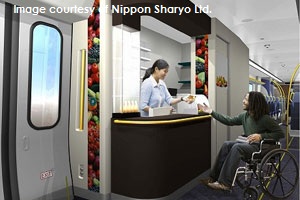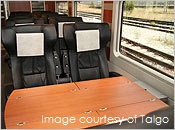High Speed Rail: A Wise Choice for Indiana
The Rationale
The nation-and Indiana-needs a new approach to public transportation as our existing systems reach capacity. Although our awareness of the risks of our current course is not always clear, the challenges become apparent when we study the trends and consider the challenges we will face if we don't make transportation policy course corrections.
Our current transportation system poses numerous problems.
Congestion.
As the population of the United States continues to increase, congestion of roads and airports will only grow worse. With the U.S. Census Bureau projecting population increases of 70 million people in the next quarter-century alone, traffic congestion headaches are likely to increase, as well. [1]
The U.S. Department of Transportation issued a series of images showing peak period travel congestion. While the 2002 image is not terribly alarming, the projected congestion for 2035 is ominous for the state of Indiana.
Energy Cost Risk and Economic Constraint.
The United States imports the majority of its petroleum, most of which is used for transportation. [2] This dependence on foreign sources for the raw materials to keep our nation moving, combined with volatile and rising prices, puts our nation at risk.
Environmental Degradation.
Automobile traffic contributes significantly to an enlarged carbon footprint, higher levels of ozone, and the inexorable demand for expanded roadway systems and parking lots. With each passing year, additional species of plants and animals are added to the list of those endangered-or extinct. Greenspace is fast retreating as farmlands become new highways to alleviate congestion, and Ozone Action days, on which we are encouraged to stay indoors and minimize driving for the health of ourselves and our environment, are increasing in number.
Global Competitiveness and Transportation Access.
Congestion in our airports and on our roadways continues to worsen, and projections for future decades are dire. The United States lacks the ease of movement found in most other developed nations, which offer local and long distance passenger rail along with air travel and motor vehicles, providing alternative means to move from place to place. As global companies weigh their options, America's disconnected and limited transit systems and congested cities may look less attractive than their foreign counterparts, and existing businesses looking to grow and expand in a global economy are faced with monumental challenges if they do not happen to be located near a major airport. [3]
Degraded Travel Quality Experience.

With the rising cost of fuel, airline passengers are faced with new fees and surcharges on top of the already frustrating security procedures and requirements. Once-expected services provided in the past as part of long-distance travel have now become menu options available only at additional cost, such as baggage fees, blanket charges, and in-flight meals. Our own vehicles are no longer as comfortable either, if we consider the time spent in smoggy traffic jams.
Mobility Options for All Population Segments.
Some population segments lack good transportation options. High speed passenger trains would offer enhanced mobility options to those who do not own or have ready access to an automobile--such as many college students, foreign guests, and some business travelers--or those who may not be able to drive safely, such as some elderly or disabled persons.
Escalating Employment Travel Cost and Lost Travel Time Productivity.
According to a report commissioned by the Federal Aviation Administration (FAA) and presented in 2010, domestic flight delays have a $32.9 billion dollar annual cost for the U.S. economy. That number does not address the issue of crowded roadways, which accounted for 4.2 billion hours of lost time in 2007, an average of 36 hours per person, costing the United States an estimated $87.2 billion for wasted fuel and lost productive time. [5]
High speed rail is a reasonable solution for Indiana.
High Demand for Routes in Indiana.
In a study done by America 2050, 27,000 city pairs were analyzed to determine their potential high speed rail ridership based on such factors as population size, economic activity, and existing travel markets and transit connections. Among their top 50 city pairs are numerous pairs that would require rail connections through Indiana: [6]
(City pairs and likely demand ranking)
- Chicago/Detroit (11)
- Chicago/Columbus (13)
- Chicago/Cleveland (16)
- Chicago/Louisville (35)
- Chicago/Cincinnati (39)
Positive Comprehensive Cost-Benefit Ratio for Indiana.
In the cost-benefit analysis done for the Midwest Regional Rail Initiative (MWRRI) by Transportation Economics and Management Systems, Inc. (TEMS) in late 2006, the benefit-cost ratio was found to be 1.8, making the Midwest region a prime area for high speed rail--one of the best in the nation. [7]
Growing Popularity of Rail Travel.
Rail is an increasingly popular form of transit; its popularity would likely increase with expanded service. Information from the Bureau of Transportation Statistics shows that Amtrak ridership is up about 33% in the past 10 years, from roughly 1.8 to 2.4 million passengers monthly, while airline usage increased only about 9% during that time.
High speed rail offers many benefits to Indiana.
Cost Savings Benefits, Community Benefits, Station Development Benefits and Environmental Benefits.
For more detail about these benefits, view the MWRRI Indiana Brochure.
Reliability and Safety.
Well-executed high speed rail will offer reliable travel times. Travel time for high speed rail is much less vulnerable to variable factors such as weather and traffic.
Rail is safer than car travel, and it's less susceptible to severe weather than air travel.
- In 2009, U.S. air carriers reported 52 fatalities, 3 train passengers lost their lives, and 23,382 people were killed in highway incidents involving passenger cars or light trucks. [8]
- According to an article published on Forbes.com, "Bad weather and poor runway design give Chicago the distinction of having two airports in the top 12 list for delays and cancellations--O'Hare and the much smaller Midway International." [9] Indianapolis could provide a safer, lake-effect-free alternative destination with easy access to Chicago via high speed rail.
Reduced Congestion.
High speed rail can help to reduce the increasing congestion in our nation's airports and on our nation's highways, which in many cases are at capacity and cannot be expanded without extreme difficulty and at great cost.
According to a Federal Railroad Administration report to Congress in September 2010,
In some cities, there is simply no room to expand airports or highways, regardless of whether financing is available to accomplish these projects. A high-speed and intercity passenger rail network will complement existing transportation choices and, in many cases, relieve some of the increased demand.The same report stated, "As the Brookings Institution recently found, 'continued growth in short haul air travel (500 miles or less) presents logistical, economic, and environmental challenges.'" [10]
Minimal Disruption.
This 110 mph version of high speed rail utilizing existing rights-of-way requires acquisition of very little extra land, thereby minimally disrupting communities and nature.

Increased Productivity.
High speed rail will increase travelers' productive time, allowing them to utilize electronic devices at any time during travel for work or enjoyment, while also allowing for activities such as conferences, relaxation, and freedom of movement.
High speed rail is an affordable solution for Indiana.
IPRA is working to commission an objective business case study for high speed rail in Indiana. The study will explore alternatives for funding and operating the system and will also analyze operating revenue and expense models. The intent is to help decision makers look at the business opportunities and risks that a major investment in high speed rail would create.
Looking at Alternatives.
People and cargo can be moved from place to place in several ways. One goal of the IPRA is to create a planning mindset that evaluates the long term cost-benefit ratios of the options at our disposal in order to maximize overall benefits in the long term. Building roads and operating cars and trucks on those roads is expensive and will become more expensive. Studies of travel patterns where competitive high speed rail options are offered show that an effective high speed rail network will significantly reduce the demand for more roads, cars and trucks.
Funding and Operational Options.
Preliminary information indicates potential private investor interest in designing, building, and operating a high speed rail system.[11] A business case study will help identify those corridors where the financial feasibility is high.
Public - Private Partnerships.
High speed rail projects require significant outlays for system development. Well designed systems with suitable public - private involvement can reduce taxpayer financial risk as well as societal risks and constraints posed by limited passenger transportation options.
[1] Data from Page 4 of the National Rail Plan Progress Report.
[2] Data from Page 7 of the National Rail Plan Progress Report.
[3] For just one example of the economic impact of transportation difficulties, read the OrthoWorx press release regarding the economic study of the orthopedic industry in Warsaw, Indiana.
[4] Data reported in "Flight delays cost $32.9 billion, passengers foot half the bill", an article published by UC Berkley News Center on October 18, 2010.
[5] View the 2009 Urban Mobility Report from the Texas Transportation Institute.
[6] Visit the America 2050 website for more information.
[7] View the MWRRI TEMS Report.
[8] Information gleaned from the Bureau of Transportation Statistics (BTS). View the report. More meaningful, per-passenger-mile data comparisons are difficult due to the fact that data is reported differently for different modes of transportation: air carrier data is analyzed by departures, aircraft miles, or flight hours; auto accidents are analyzed by vehicle-mile; and train data is analyzed by passenger train-miles--which must be multiplied by the number of cars on each train in order to convert to vehicle-miles. This, combined with the fact that most airplanes and trains transport far more passengers than autos, makes better comparison impossible with the data provided by the BTS.
[9] Quote from the Forbes.com article entitled "America's Most Dangerous Airports", published February 23, 2007.
[10] Cited information from the Metropolitan Policy Program at Brookings, Metropolitan Infrastructure Initiative Series, October 2009.
[11] Data gleaned from an article entitled "Too Often, the 'Trouble' with High-Speed Rail is Misinformation" on Wired.com.
